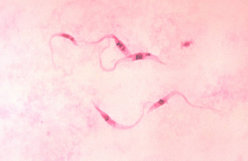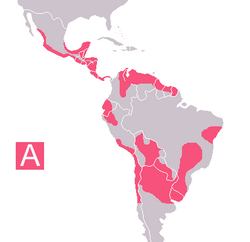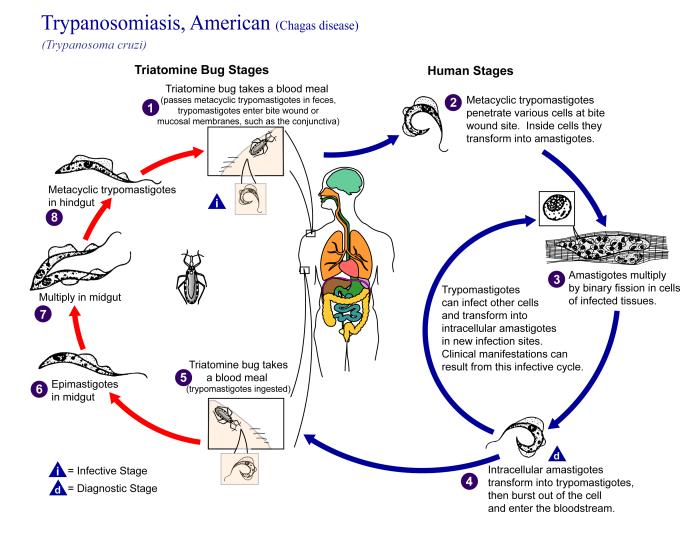Definition
Chagas' disease is named after Dr. Carlos Chagas who first found the organism in the early 1900s. It involves damage to the nerves that control the heart, digestive and other organs, and eventually leads to damage to these organs. Worldwide, Chagas' disease affects over 15 million persons, and kills 50,000 each year. Researchers believe that the parasite that causes the disease is only found in the Americas.
Description
When a person is infected with Chagas' disease, the parasite known as Trypanosoma cruzi first causes a mild, short-lived period of "acute" illness; then after a long period without symptoms, the effects of the infection begin to appear. The heart, esophagus, and colon are most frequently involved. These organs become unable to contract properly, and begin to stretch or dilate.
Causes & symptoms
T. cruzi is carried by insects or bugs known as reduviid or "kissing bugs." These insects are very common in Central and South America where they inhabit poorly constructed houses and huts. The insects deposit their waste material, exposing inhabitants to the parasites. The parasites then enter the body by way of a cut or via the eyes or mouth. T. cruzi can also be transmitted by blood transfusion. Eating uncooked, contaminated food or breast-feeding can also transmit the disease. The reduviids, in turn, become infected with the parasite by biting infected animals and humans.
There are three phases related to infection:
- Acute phase lasts about 2 months, with non-specific symptoms of low grade fever, headache, fatigue, and enlarged liver or spleen.
- Indeterminate phase lasts 10-20 years, during which time no symptoms occur, but the parasites are reproducing in various organs.
- Chronic phase is the stage when symptoms related to damage of major organs (heart, esophagus, colon) begins.
In the chronic phase, irregularities of heart rhythm, heart failure, and blood clots cause weakness, fainting, and even sudden death.
Esophageal symptoms are related to difficulty with swallowing and chest pain. Because the esophagus does not empty properly, food regurgitates into the lungs causing cough, bronchitis, and repeated bouts of pneumonia. Inability to eat, weight loss, and malnutrition become a significant factor in affecting survival.
Involvement of the large intestine (colon) causes constipation, distention, and abdominal pain.
Diagnosis
The best way to diagnose acute infection is to identify the parasites in tissue or blood. Occasionally it is possible to culture the organism from infected tissue, but this process usually requires too much time to be of value. In the chronic phase, antibody levels can be measured. Efforts to develop new, more accurate tests are ongoing.
Treatment
In most cases treatment of symptoms is all that is possible. Present medications can reduce the duration and severity of an acute infection, but are only 50% effective, at best, in eliminating the organisms.
Cardiac effects are managed with pacemakers and medications. Esophageal complications require either endoscopic or surgical methods to improve esophageal emptying, similar to those used to treat the disorder known as achalasia. Constipation is treated by increasing fiber and bulk laxatives, or removal of diseased portions of the colon.
Prognosis
Those patients with gastrointestinal complications often respond to some form of treatment. Cardiac problems are more difficult to treat, particularly since transplant would rekindle infection.
Prevention
Visitors traveling to areas of known infection should avoid staying in mud, adobe, or similar huts. Mosquito nets and insect repellents are useful in helping to avoid contact with the bugs. Blood screening is not always effective in many regions where infection is common. It is necessary to carefully screen people who have emigrated from Central and South America before they make blood donations.
Key Terms
- Achalasia
- An esophageal disease of unknown cause, in which the lower sphincter or muscle is unable to relax normally, and leads to the accumulation of material within the esophagus.
- Endoscopy
- Exam using an endoscope (a thin flexible tube which uses a lens or miniature camera to view various areas of the gastrointestinal tract). When the procedure is performed to examine certain organs such as the bile ducts or pancreas, the organs are not viewed directly, but rather indirectly through the injection of x-ray.
- Parasite
- An organism that lives on or in another and takes nourishment (food and fluids) from that organism.
- Regurgitation
- Flow of material back up the esophagus and into the throat or lungs.
Further Reading
For Your Information
Books
- Kirchoff, Louis V. "Trypanosomiasis." In Harrison's Principles of Internal Medicine, edited by Anthony S. Fauci, et al. New York: McGraw-Hill, 1998, pp. 1193-1196.
- Owen, Robert L. "American Trypanosomiasis (Chagas' Disease)." In Sleisenger & Fordtran's Gastrointestinal and Liver Disease, edited by Mark Feldman, et al. Philadelphia: W.B. Saunders Company, 1997, pp.1676-1679.
Periodicals
- Kirchoff, Louis V. "American Trypanosomiasis (Chagas' Disease)." Gastroenterology Clinics of North America. (September 1996): 517-533.
- Kirchoff, Louis V. "Current Concepts: American Trypanosomiasis (Chagas' Disease)-A Tropical Disease Now in the United States." New England Journal of Medicine. 329 (9) (1993): 639.
Other
- "Chagas' disease (American trypanosomiasis)." http://www.cdc.gov/ncidod/dpd/chagas.htm.
- "New approaches to Chagas' disease control may contain genetically engineered bacteria." http://www.cdc.gov/ncidod/focus/vol6no3/chagas.htm.
Gale Encyclopedia of Medicine. Gale Research, 1999.




